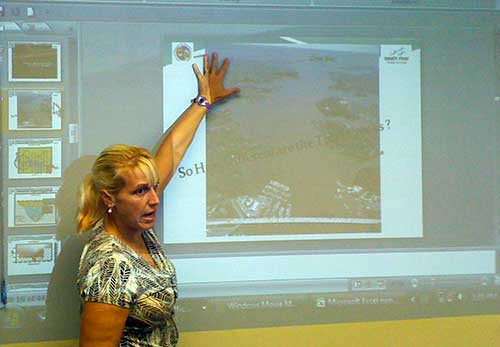Discussion following Andrew Muller and Diana Muller seminar on Emerging hypoxia trends in the South River
Bill Dennison ·This blog post discusses the seminar given by Andrew and Diana Muller at the IAN Seminar Series on August 31, 2010.
Pierre Henkart noted that the Severn River had persistent anoxia between June and September which includes noticeable hydrogen sulfide and asked why the South River anoxia was not as pronounced or persistent. Andrew and Diana discussed the increased tidal flushing in the South River compared with the Severn River with its shallow and wide sill at the Severn mouth. They pointed out that the South River does not experience regular injections of low dissolved oxygen water from the Chesapeake Bay mainstem. Monitoring data from both the South and Severn Rivers indicate that the Chesapeake Bay Program model which extrapolates dissolved oxygen levels from the monitoring network which does not significant penetrate into the rivers is inadequate for tributaries.

The negative feedbacks that occur once anoxia is obtained were discussed. Enhanced sediment nutrient release, which includes both nitrogen and phosphorus release, occurs when water column dissolved oxygen reaches anoxia. This provides a negative feedback, in which increased sediment nutrient release leads to more phytoplankton growth and the subsequent decay of these phytoplankton leads to more oxygen consumption.
There was a discussion of limiting nutrients in the tributaries, based on the dissolved nitrogen and phosphorus data presented by Diana and Andrew. The bioassays indicate nitrogen was limiting and phosphorus delivery, occurring in large (0.3-0.4 mg/L dissolved inorganic phosphorus) spikes associated with runoff, resulted in excess phosphorus.
Andrew discussed REMUS, the autonomous vehicle he used to produce detailed river profiles. It was an "awesome toy" worth around $400,000 that can detect the onset of wind and current associated stratification and other short term processes that typical onboard profiling would not be able to do in a synoptic fashion allowed by the REMUS. Andrew said that the REMUS was 'flown' without incident, apart from one collision Keith the soft bottom which did not result in any damage. The utility of REMUS for more widespread data collection was discussed and the insights that could be gained about short term physical processes with important ecological implications would help develop a better understanding of Chesapeake Bay dynamics.

The South River watershed was discussed, and the 'Gateway to Washington, D.C.' status, where many people have their primary residence in and around Washington, D.C., with secondary homes along the South River. The watershed at one time was primarily agricultural and is now mostly residential development. The second home incomes are juxtaposed with some low income local residents who regularly fish in the South River, and consume these fish, in spite of potential contamination. Catfish caught up near the Route 50 bridge regularly have lesions, and the water color is often 'chocolate milk' colored.
About the author
Bill Dennison

Dr. Bill Dennison is a Professor of Marine Science and Vice President for Science Application at the University of Maryland Center for Environmental Science.

